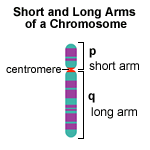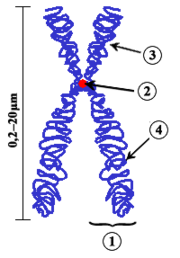Locus (genetics)


In the fields of genetics and evolutionary computation, a locus (plural loci) is the specific location of a gene or DNA sequence on a chromosome. A variant of the DNA sequence at a given locus is called an allele. The ordered list of loci known for a particular genome is called a genetic map. Gene mapping is the process of determining the locus for a particular biological trait.
Diploid and polyploid cells whose chromosomes have the same allele of a given gene at some locus are called homozygous with respect to that gene, while those that have different alleles of a given gene at a locus, heterozygous with respect to that gene.
Nomenclature
The chromosomal locus of a gene might be written "6p21.3".
| Component | Explanation |
| 6 | The chromosome number. |
| p | The position is on the chromosome's short arm (p for petit in French); q indicates the long arm. |
| 21.3 | The numbers that follow the letter represent the position on the arm: band 2, section 1, sub-band 3. The bands are visible under a microscope when the chromosome is suitably stained. Each of the bands is numbered, beginning with 1 for the band nearest the centromere. Sub-bands and sub-sub-bands are visible at higher resolution. |
A range of locations is specified in a similar way. For example, the locus of gene OCA1 may be written "11q1.4-q2.1", meaning it is on the long arm of chromosome 11, somewhere in the range from sub-band 4 of band 1, and sub-band 1 of band 2.
The ends of a chromosome are labeled "ptel" and "qtel", and so "2qtel" refers to the telomere of the long arm of chromosome 2.
See also
- Chromosomal translocation
External links
| This genetics article is a stub. You can help Wikipedia by expanding it. |